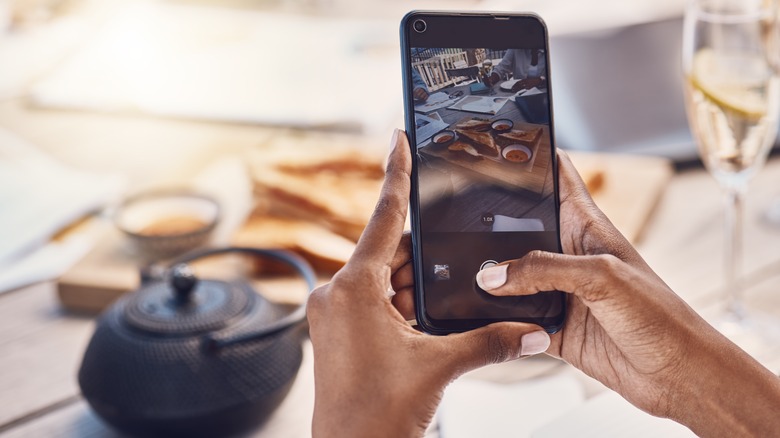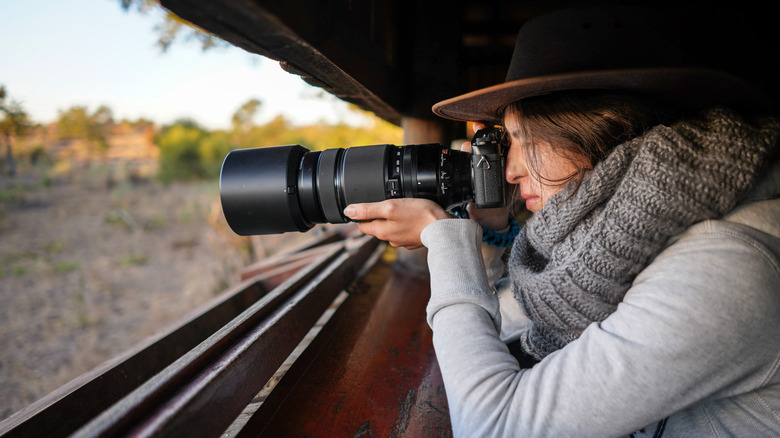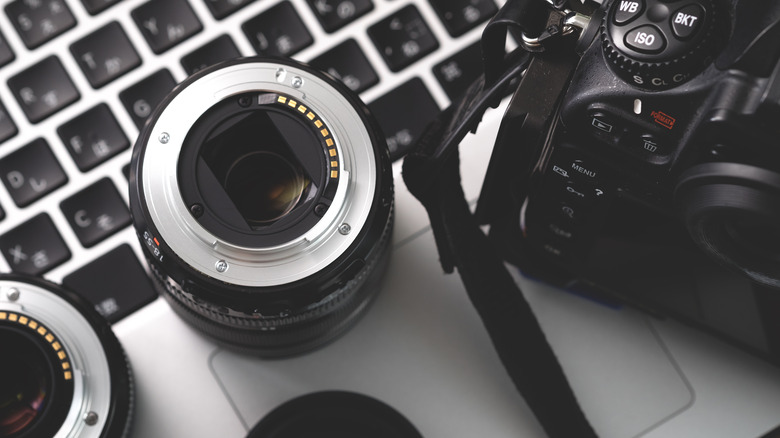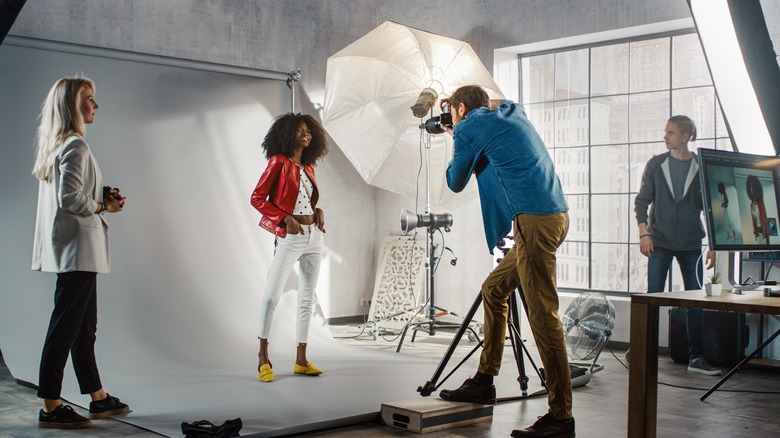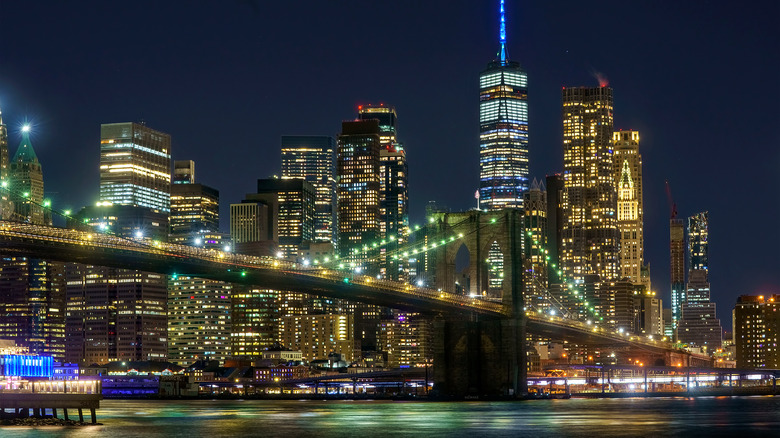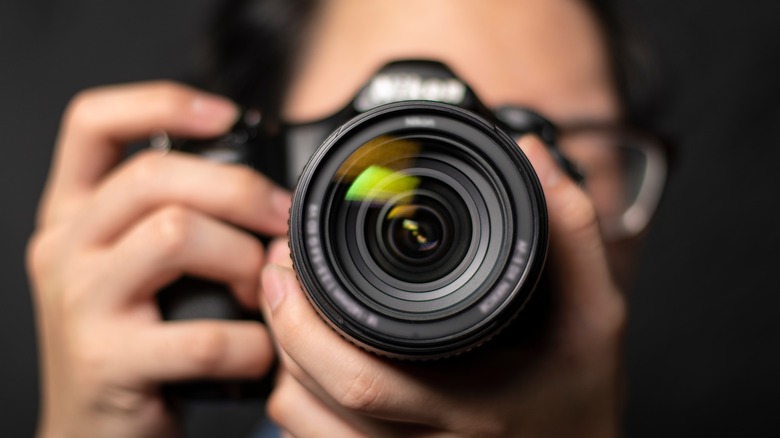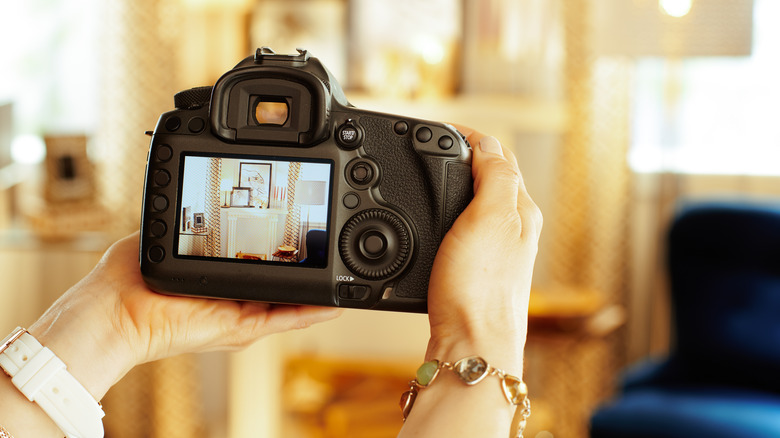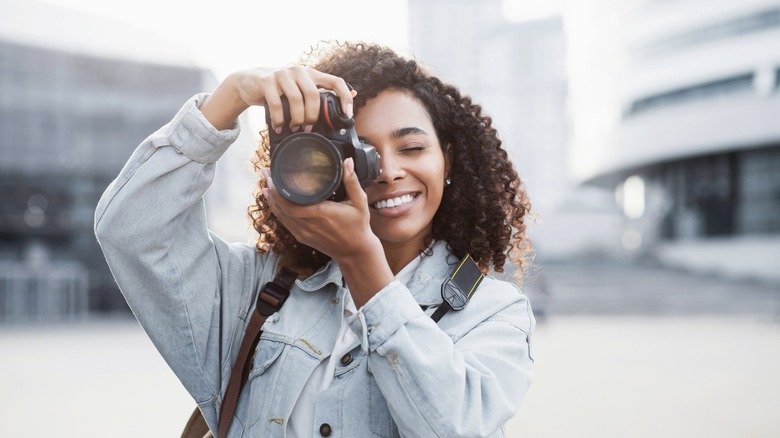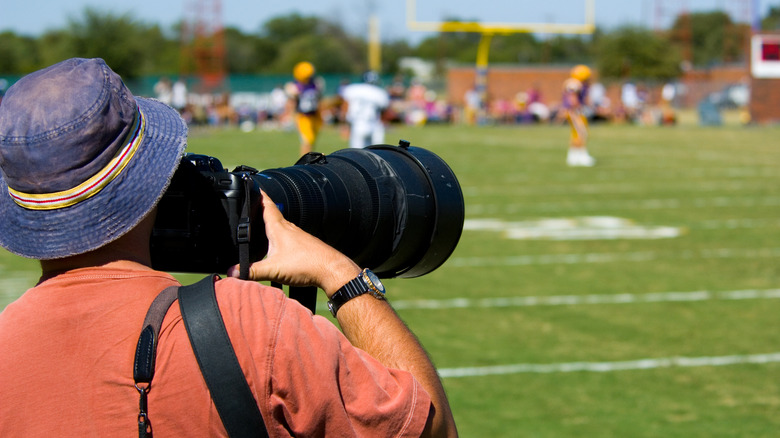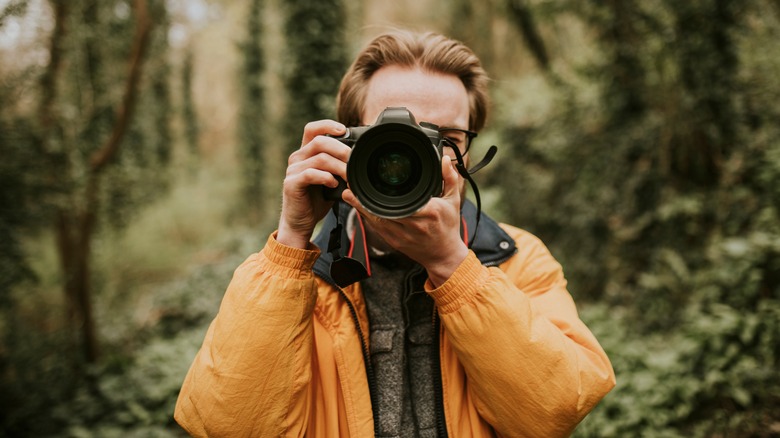Digital Camera Features We'll Never See In Smartphone Cameras
Mobile photography has always been a controversial topic among photographers. While many folks welcome new technology and a new medium — evidenced by countless guides on taking the best smartphone photos — some old-school photographers are hesitant to embrace the format with open arms. Now that everyone has a smartphone in their pocket, we all have instant access to a camera at a moment's notice. And, thanks to ever-changing advancements in tech, we see improvements in resolution, zoom, and shooting modes with the release of every hot new phone. Still, there are shortfalls. No matter how much the smartphone evolves, there remain things it simply cannot do — or do particularly well.
There's a saying that "the best camera is the one you have," and no tool will ever be more valuable than a photographer's own two eyes. You certainly don't need a fancy camera to be a great photographer. That said, there are functions and features of a digital camera we'll likely never see with smartphone cameras. Sometimes, the old ways are the best.
Optical zoom
If you've ever zoomed in on a subject with your smartphone only to watch the image quality plummet, you've experienced the limitations of digital zoom. Digital zoom relies on cropping out sections of an image and magnifying it to fill the frame, resulting in a photo that's pixelated or blurry. Optical zoom instead brings the image closer to you before capturing it. It does this by mechanically moving the camera's lens assembly back and forth, hence why a variable focal length lens will expand and retract as you zoom in or out on your subject. Optical zoom is lossless, meaning that image quality remains strong since it's not being digitally cropped and blown up (via Expert Photography).
You can find modern smartphones touting optical zoom these days (such as the iPhone 14 Pro), but a smartphone's version of optical zoom is not the same as a traditional camera's, and likely never will be. Keeping a thin profile is paramount to smartphone design, and there simply isn't enough room to move a lens assembly back and forth. Instead, manufacturers have "solved" this problem by placing multiple lenses on the back of our phones, each one with a different focal length (via The Smartphone Photographer). When you're zooming in and out, your smartphone's camera will switch to the appropriate lens based on the shot you're trying to get. Even the Sony Xperia 1 IV, which advertises the "world's first true optical zoom lens" only supports two different focal lengths. While this will yield better image quality than digital zoom, space and image sensor limitations will probably never truly match the quality of real optical zoom with a traditional camera and lens.
Lens assortment
An undeniable advantage proper DSLRs and mirrorless cameras have over smartphones is the wide variety of compatible lenses. While lens attachments for smartphones do exist and have for a while, we'll likely never see a range of glass as extensive or high-quality as those put out by Canon, Sony, Nikon, or other dedicated camera manufacturers. Most of these options are small, which limits the mechanics and made of plastic, which limits quality even further.
As stated earlier, most modern smartphones come with multiple lenses. There's often a "standard" or wide-angle field of view on the main lens, then phones like the Galaxy S22 Plus also throw an ultra-wide and telephoto lens in the mix. If this doesn't cover the bases for you, there are various modes, attachments, and apps that can give you a workable (often fully digital) solution for achieving things like fisheye, macro, and tilt-shift — but it's just not the same as camera glass. If you shoot things like wildlife, sports, or anything else requiring a lot of speed and distance, you can pretty much count on the shot you take with your phone to be vastly inferior to one taken with a digital camera and the appropriate lens.
Professional-quality bokeh
One of the most aesthetically-pleasing qualities of a portrait or macro shot taken at a wide aperture is the background blur. This out-of-focus effect is called bokeh, which comes from the Japanese word "boke," meaning "blur" or "haze" (per Nikon). Bokeh is most evident in the highlights of an image, where points of light will take on the shape of the lens aperture: A lens with more circular diaphragm blades will display rounded bokeh, while a lens with fewer blades will have more hexagon-shaped bokeh.
Technically, background blur is a feature of a fast, high-quality lens (at least f/2.8) and not the camera body itself. However, it's still something we're unlikely to see become comparable in mobile photography.
Smartphones have come a long way with various portrait and macro modes that blur the background using depth-sensing software (via Wired). It works well for what it is, but things get a little hazy when you look closer — literally. You'll often see edges that weren't clipped cleanly, and portrait modes seem to have a tough time neatly isolating hair and things in the foreground. In a side-by-side comparison of a portrait taken with a phone vs. one with a DSLR and a fast lens, there simply is no comparison. As Wired points out, "You can only fake it so far before the metaphorical wires and scraps of gaffer tape begin to show."
Flash integration
Sometimes, you need to make your own light. When you're shooting portraits, stuck in low light, or working in a professional setting such as a wedding or studio, flash can be an integral part of your setup. Digital cameras come equipped with a variety of means to hook up a light source: built-in pop-up flashes, hot shoes, connections for sync cables, or a combination of all three. You can also set multiple lights up to communicate with each other and fire simultaneously via cable or wireless trigger (radio or infrared).
Smartphones can't hold a candle to this level of lighting control and integration. Regardless of the manufacturer, the built-in flash that comes with our phones is weak, unpredictable, and fixed. You aren't able to make adjustments for subject distance, exposure compensation, or output. Subjects are often washed out or over-exposed while the background remains too dark. If you want any say in the matter, that's too bad: Your only options are On, Off, or Auto.
Over the years, there have been attempts to create off-camera flashes for smartphones that never really took off. You can also find "studio strobes" for smartphones that have to be held in one hand while you shoot single-handedly with the other. Your options here are limited, however, and results will never rival the output or control of professional lighting. As cool as it would be to have a hot shoe on our iPhone, that day is probably never coming.
Large image sensor
It's no secret that smartphones are abundantly lackluster when trying to take photos at night. Low-light photos remain one of the biggest challenges in mobile photography, and despite all the advancements in technology, we just can't quite get the same quality as a good digital camera. There's a reason for this.
Phones are physically smaller than digital cameras, which means their image sensors are smaller, too. According to Photo Review, common sizes for image sensors in smartphones are 4.89x3.67mm and 5.79x4.1mm. By contrast, the sensor in a fixed-lens digicam is more than double that size. In a full-frame professional body, the sensor is the equivalent size of that in a 35mm film camera (a whopping 24x36mm). Why is this important? The image sensor is the brain of the operation. It's what allows the device to convert light into electrical signals that then become a digital image (via Association for Advancing Automation). The bigger the sensor, the more information that the "brain" can process. This is why low-light images with a digital camera will almost always be superior.
Don't get tripped up by resolution; they are not the same. It may sound impressive that your smartphone comes with a 108-megapixel camera when comparing it to a 45-megapixel, full-frame digital camera. But individual pixels captured on a large image sensor are physically larger than pixels captured on a small image sensor (via How-To-Geek). The latter results in more noise and less accurate color rendition.
Ergonomic design
Modern smartphone manufacturers are in an ongoing, never-ending competition for the most streamlined design. Consumers want phones that fit comfortably in a hand, in a pocket, in a purse — anything beyond a thin rectangle doesn't get much traction these days. While that's a fine form factor for the multitude of roles we ask our phones to play, when it comes to taking pictures, it simply isn't as comfortable as holding a camera.
Cameras are designed to sit securely in the hand, with all the necessary buttons and controls comfortably at your fingertips. They're often wrapped with a texturized rubber exterior for extra grip when you're shooting. You can also attach various accessories like battery grips or hand straps that give you even more versatility in handling the device. It's safe to say that even if smartphones evolve beyond that thin rectangle, they'll likely never reach a point resembling the ergonomic build of a traditional camera. Instead, we're destined to precariously take photos with our phones balanced between our thumbs and forefingers.
Dedicated controls and customizable buttons
Spend enough time shooting with your DSLR or mirrorless camera, and operating it becomes muscle memory. Your fingers know exactly where to press, toggle, or tap to change ISO, switch shooting modes, set your autofocus, or change any number of settings. With a little practice, you won't even need to look away from your subject matter while you're shooting — and you'll never miss a shot. As a plus, many of these buttons are customizable, letting you program the most useful camera functions (like back-button autofocus) to be within instant reach (via Improve Photography).
Smartphones are meant for many things besides just taking photos, so they inherently lack the controls needed to quickly manipulate whatever camera settings are available to you. At least, these controls aren't as easily accessible as they are on a camera with a dedicated shooting mode dial, ISO button, autofocus point selector, and so on. The iPhone, for example, takes a couple of taps within the camera app to uncover options for changing the exposure, f/stop, flash, or self-timer.
Viewfinder
Having a viewfinder is somewhat of a take-it-or-leave-it option these days, as framing up a shot on a smartphone or camera LCD screen is pretty convenient. Regardless, a viewfinder is one camera feature we'll probably never see in smartphones. The components simply don't lend themselves to the form factor of a phone.
If you take a lot of photos, there are some benefits to using a viewfinder, and there's a reason many photographers still prefer shooting that way. Viewfinders are a more accurate representation of what the human eye sees before a digital processor gets a hold of the image. They also force you to hold the camera up close to the body, which makes it easier to balance heavier gear, cutting down on shake. And, if you've ever tried to take a photo in the glaring sun, you know that it can be impossible to make out anything on a screen — your image, the controls, anything — because screens only get so bright. Viewfinders don't have this problem. So while a viewfinder isn't an absolutely necessary feature anymore, it's still nice to have the option. And for smartphones, it's unlikely we ever will.
Speed
Nothing makes inadequate photo gear more evident than shooting action. Sports, animals, kids, and anything else that moves very fast from very far away requires the right camera and lens to achieve professional-quality (or even decent) photos. A smartphone can get you some okay snaps, but if you're looking for anything more than that, you'll be sorely disappointed.
If you have a smartphone with particularly good autofocus capabilities — and an auto-lock feature for that autofocus — you'll at least have a leg up. But here, really, nothing is going to beat a DLSR or mirrorless camera equipped with a fast lens. Not only does the camera's processing speed need to be fast, but the lens should have a wide aperture that lets you crank the shutter speed to something fast enough to freeze action. It's a heavy-hitting combo that even the most advanced modern smartphones can't keep up with, and we'll likely never see the two compare.
Physics and light vs. digital manipulation
At the end of the day, photography, as a concept, is based on physics. Understanding how light works is a fundamental part of being a photographer, and interpreting that light into an image is the fundamental function of a camera (along with its lens). There is something inherently special, almost tangible about this process.
Smartphone cameras are trying their hardest to do all the things a regular digital camera can do. In many ways, they get pretty close, and it's been incredible to watch their evolution. But where they can't make it, they fake it. Depth-sensing blur software, "optical zoom" which isn't true optical zoom, and other camera phone features rely on a combination of digital manipulation and artificial intelligence. It's simply the easiest way for such a small device to accomplish comparable results, and there will more than likely always be a large software component driving smartphone cameras. Here, the moving parts and internal workings of a traditional camera will always do the job a little bit better. It's just physics.
